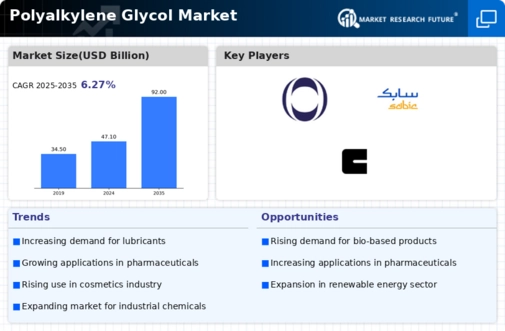Market Analysis
In-depth Analysis of Polyalkylene Glycol Market Industry Landscape
The Polyalkylene Glycol (PAG) Market is influenced by several key dynamics that shape its growth and trajectory:
Increasing Demand from End-Use Industries: The demand for polyalkylene glycols is steadily increasing across various end-use industries such as automotive, construction, personal care, and industrial manufacturing. PAGs are valued for their versatility, serving as lubricants, surfactants, and polyurethane foam additives, among other applications.
Growing Automotive Sector: The automotive industry is a major consumer of polyalkylene glycols, particularly in automotive lubricants and coolant formulations. With the automotive sector experiencing growth in both production and sales globally, the demand for PAG-based lubricants and functional fluids is on the rise.
Rising Adoption in Industrial Applications: Polyalkylene glycols find extensive use in industrial applications such as hydraulic fluids, metalworking fluids, and industrial lubricants due to their excellent lubricating properties and thermal stability. As industrial activities expand worldwide, the demand for PAG-based products is expected to increase accordingly.
Expansion in Construction Sector: The construction industry is another significant consumer of polyalkylene glycols, primarily in applications such as concrete admixtures, sealants, and coatings. With infrastructure development projects underway in many regions, the demand for PAG-based construction chemicals is growing steadily.
Shift towards Bio-based Polyalkylene Glycols: There is a notable trend towards the use of bio-based polyalkylene glycols derived from renewable feedstocks such as vegetable oils and bioethanol. This shift is driven by increasing environmental awareness and regulatory pressure to reduce dependence on petroleum-based chemicals.
Technological Advancements: Continuous research and development efforts are leading to advancements in polyalkylene glycol technology, resulting in improved product performance and expanded application possibilities. Manufacturers are investing in R&D to develop PAGs with enhanced properties such as higher viscosity index, better thermal stability, and improved biodegradability.
Focus on Sustainability: Sustainability concerns are driving the adoption of environmentally friendly PAG formulations with reduced toxicity and biodegradability. Manufacturers are developing eco-friendly PAG products to align with the growing demand for sustainable solutions in various industries.
Market Consolidation and Strategic Partnerships: The polyalkylene glycol market is witnessing consolidation through mergers, acquisitions, and strategic partnerships among key players. These collaborations aim to strengthen market presence, expand product portfolios, and leverage synergies in research, production, and distribution.
Regulatory Landscape: Regulatory standards and guidelines governing the production, use, and disposal of polyalkylene glycols play a significant role in shaping market dynamics. Manufacturers must comply with regulations related to product safety, environmental impact, and labeling requirements in different regions.
Impact of COVID-19 Pandemic: The COVID-19 pandemic has had varying effects on the polyalkylene glycol market. While disruptions in supply chains and manufacturing operations initially affected market growth, the demand for PAG-based products in essential industries such as healthcare, food processing, and pharmaceuticals remained relatively stable.






Leave a Comment